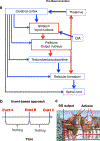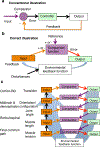The Basal Ganglia in Action
- PMID: 27306757
- PMCID: PMC6500733
- DOI: 10.1177/1073858416654115
The Basal Ganglia in Action
Abstract
The basal ganglia (BG) are the major subcortical nuclei in the brain. Disorders implicating the BG are characterized by diverse symptoms, but it remains unclear what these symptoms have in common or how they can be explained by changes in the BG circuits. This review summarizes recent findings that not only question traditional assumptions about the role of the BG in movement but also elucidate general computations performed by these circuits. To explain these findings, a new conceptual framework is introduced for understanding the role of the BG in behavior. According to this framework, the cortico-BG networks implement transition control in an extended hierarchy of closed loop negative feedback control systems. The transition control model provides a solution to the posture/movement problem, by postulating that BG outputs send descending signals to alter the reference states of downstream position control systems for orientation and body configuration. It also explains major neurological symptoms associated with BG pathology as a result of changes in system parameters such as multiplicative gain and damping.
Keywords: action selection; basal ganglia; control theory; dopamine; motor control; movement; negative feedback; striatum; substantia nigra.
Conflict of interest statement
Declaration of Conflicting Interests
The author declares no potential conflicts of interest with respect to the research, authorship, and publication of this article.
Figures






Similar articles
-
Action, time and the basal ganglia.Philos Trans R Soc Lond B Biol Sci. 2014 Jan 20;369(1637):20120473. doi: 10.1098/rstb.2012.0473. Print 2014 Mar 5. Philos Trans R Soc Lond B Biol Sci. 2014. PMID: 24446506 Free PMC article. Review.
-
Competition between feedback loops underlies normal and pathological dynamics in the basal ganglia.J Neurosci. 2006 Mar 29;26(13):3567-83. doi: 10.1523/JNEUROSCI.5050-05.2006. J Neurosci. 2006. PMID: 16571765 Free PMC article.
-
Functional anatomy of the basal ganglia: limbic aspects.Rev Neurol (Paris). 2012 Aug-Sep;168(8-9):569-75. doi: 10.1016/j.neurol.2012.06.015. Epub 2012 Aug 14. Rev Neurol (Paris). 2012. PMID: 22902172 Review.
-
The functional logic of corticostriatal connections.Brain Struct Funct. 2017 Mar;222(2):669-706. doi: 10.1007/s00429-016-1250-9. Epub 2016 Jul 13. Brain Struct Funct. 2017. PMID: 27412682 Free PMC article. Review.
-
The Role of Striatal Feedforward Inhibition in the Maintenance of Absence Seizures.J Neurosci. 2016 Sep 14;36(37):9618-32. doi: 10.1523/JNEUROSCI.0208-16.2016. J Neurosci. 2016. PMID: 27629713 Free PMC article.
Cited by
-
Brain region-specific disruption of Shank3 in mice reveals a dissociation for cortical and striatal circuits in autism-related behaviors.Transl Psychiatry. 2018 Apr 27;8(1):94. doi: 10.1038/s41398-018-0142-6. Transl Psychiatry. 2018. PMID: 29700290 Free PMC article.
-
Zona incerta distributes a broad movement signal that modulates behavior.Elife. 2023 Dec 4;12:RP89366. doi: 10.7554/eLife.89366. Elife. 2023. PMID: 38048270 Free PMC article.
-
A one-photon endoscope for simultaneous patterned optogenetic stimulation and calcium imaging in freely behaving mice.Nat Biomed Eng. 2023 Apr;7(4):499-510. doi: 10.1038/s41551-022-00920-3. Epub 2022 Aug 15. Nat Biomed Eng. 2023. PMID: 35970930
-
Optimal time lags from causal prediction model help stratify and forecast nervous system pathology.Sci Rep. 2021 Oct 22;11(1):20904. doi: 10.1038/s41598-021-00156-2. Sci Rep. 2021. PMID: 34686679 Free PMC article.
-
Mediodorsal Thalamus Contributes to the Timing of Instrumental Actions.J Neurosci. 2020 Aug 12;40(33):6379-6388. doi: 10.1523/JNEUROSCI.0695-20.2020. Epub 2020 Jun 3. J Neurosci. 2020. PMID: 32493711 Free PMC article.
References
-
- Alexander GE, DeLong MR, Strick PL (1986) Parallel organization of functionally segregated circuits linking basal ganglia and cortex. Annu Rev Neurosci 9:357–381. - PubMed
-
- Barter JW, Castro S, Sukharnikova T, Rossi MA, Yin HH (2014) The role of the substantia nigra in posture control. European Journal of Neuroscience 39 (9):1465–1473. - PubMed
Publication types
MeSH terms
Grants and funding
LinkOut - more resources
Full Text Sources
Other Literature Sources

